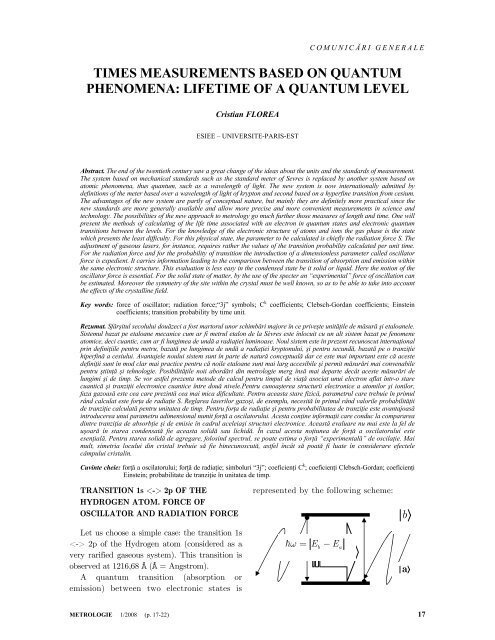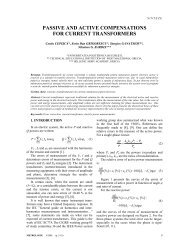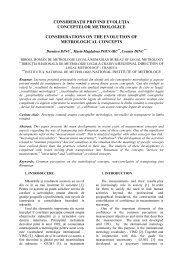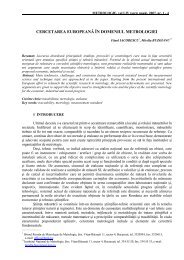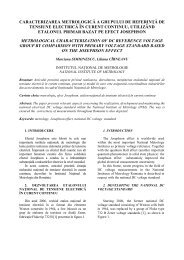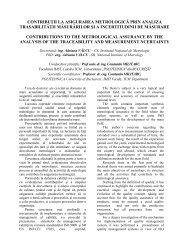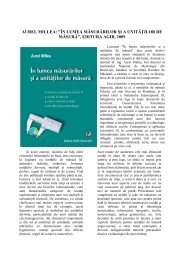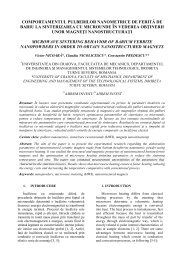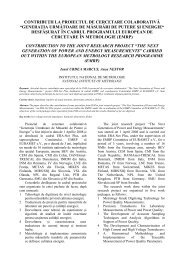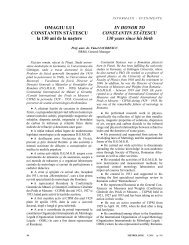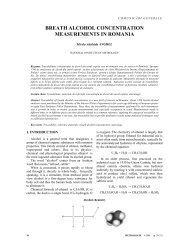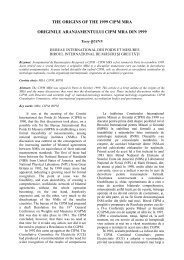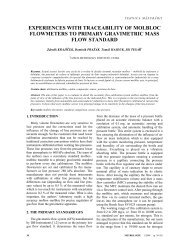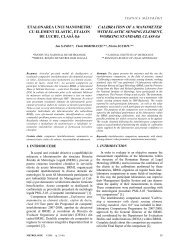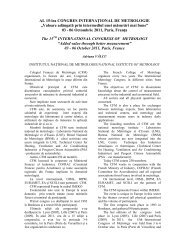Cristian Florea, Times measurements based on quantum ...
Cristian Florea, Times measurements based on quantum ...
Cristian Florea, Times measurements based on quantum ...
Create successful ePaper yourself
Turn your PDF publications into a flip-book with our unique Google optimized e-Paper software.
COMUNICĂ RI GENERALE<br />
TIMES MEASUREMENTS BASED ON QUANTUM<br />
PHENOMENA: LIFETIME OF A QUANTUM LEVEL<br />
<str<strong>on</strong>g>Cristian</str<strong>on</strong>g> FLOREA<br />
ESIEE – UNIVERSITE-PARIS-EST<br />
Abstract. The end of the twentieth century saw a great change of the ideas about the units and the standards of measurement.<br />
The system <str<strong>on</strong>g>based</str<strong>on</strong>g> <strong>on</strong> mechanical standards such as the standard meter of Sevres is replaced by another system <str<strong>on</strong>g>based</str<strong>on</strong>g> <strong>on</strong><br />
atomic phenomena, thus <strong>quantum</strong>, such as a wavelength of light. The new system is now internati<strong>on</strong>ally admitted by<br />
definiti<strong>on</strong>s of the meter <str<strong>on</strong>g>based</str<strong>on</strong>g> over a wavelength of light of krypt<strong>on</strong> and sec<strong>on</strong>d <str<strong>on</strong>g>based</str<strong>on</strong>g> <strong>on</strong> a hyperfine transiti<strong>on</strong> from cesium.<br />
The advantages of the new system are partly of c<strong>on</strong>ceptual nature, but mainly they are definitely more practical since the<br />
new standards are more generally available and allow more precise and more c<strong>on</strong>venient <str<strong>on</strong>g>measurements</str<strong>on</strong>g> in science and<br />
technology. The possibilities of the new approach to metrology go much further those measures of length and time. One will<br />
present the methods of calculating of the life time associated with an electr<strong>on</strong> in <strong>quantum</strong> states and electr<strong>on</strong>ic <strong>quantum</strong><br />
transiti<strong>on</strong>s between the levels. For the knowledge of the electr<strong>on</strong>ic structure of atoms and i<strong>on</strong>s the gas phase is the state<br />
which presents the least difficulty. For this physical state, the parameter to be calculated is chiefly the radiati<strong>on</strong> force S. The<br />
adjustment of gaseous lasers, for instance, requires rather the values of the transiti<strong>on</strong> probability calculated per unit time.<br />
For the radiati<strong>on</strong> force and for the probability of transiti<strong>on</strong> the introducti<strong>on</strong> of a dimensi<strong>on</strong>less parameter called oscillator<br />
force is expedient. It carries informati<strong>on</strong> leading to the comparis<strong>on</strong> between the transiti<strong>on</strong> of absorpti<strong>on</strong> and emissi<strong>on</strong> within<br />
the same electr<strong>on</strong>ic structure. This evaluati<strong>on</strong> is less easy in the c<strong>on</strong>densed state be it solid or liquid. Here the noti<strong>on</strong> of the<br />
oscillator force is essential. For the solid state of matter, by the use of the specter an “experimental” force of oscillati<strong>on</strong> can<br />
be estimated. Moreover the symmetry of the site within the crystal must be well known, so as to be able to take into account<br />
the effects of the crystalline field.<br />
Key words: force of oscillator; radiati<strong>on</strong> force;“3j” symbols; C k coefficients; Clebsch-Gordan coefficients; Einstein<br />
coefficients; transiti<strong>on</strong> probability by time unit.<br />
Rezumat. Sfârşitul secolului douăzeci a fost martorul unor schimbări majore în ce priveşte unităţile de măsură şi etaloanele.<br />
Sistemul bazat pe etaloane mecanice cum ar fi metrul etal<strong>on</strong> de la Sèvres este înlocuit cu un alt sistem bazat pe fenomene<br />
atomice, deci cuantic, cum ar fi lungimea de undă a radiaţiei luminoase. Noul sistem este în prezent recunoscut internaţi<strong>on</strong>al<br />
prin definiţiile pentru metru, bazată pe lungimea de undă a radiaţiei krypt<strong>on</strong>ului, şi pentru secundă, bazată pe o tranziţie<br />
hiperfină a cesiului. Avantajele noului sistem sunt în parte de natură c<strong>on</strong>ceptuală dar ce este mai important este că aceste<br />
definiţii sunt în mod clar mai practice pentru că noile etaloane sunt mai larg accesibile şi permit măsurări mai c<strong>on</strong>venabile<br />
pentru ştiinţă şi tehnologie. Posibilităţile noii abordări din metrologie merg însă mai departe decât aceste măsurări de<br />
lungimi şi de timp. Se vor astfel prezenta metode de calcul pentru timpul de viaţă asociat unui electr<strong>on</strong> aflat într-o stare<br />
cuantică şi tranziţii electr<strong>on</strong>ice cuantice între două nivele.Pentru cunoaşterea structurii electr<strong>on</strong>ice a atomilor şi i<strong>on</strong>ilor,<br />
faza gazoasă este cea care prezintă cea mai mica dificultate. Pentru aceasta stare fizică, parametrul care trebuie în primul<br />
rând calculat este forţa de radiaţie S. Reglarea laserilor gazoşi, de exemplu, necesită în primul rând valorile probabilităţii<br />
de tranziţie calculată pentru unitatea de timp. Pentru forţa de radiaţie şi pentru probabilitatea de tranziţie este avantajoasă<br />
introducerea unui parametru adimensi<strong>on</strong>al numit forţă a oscilatorului. Acesta c<strong>on</strong>ţine informaţii care c<strong>on</strong>duc la compararea<br />
dintre tranziţia de absorbţie şi de emisie în cadrul aceleiaşi structuri electr<strong>on</strong>ice. Această evaluare nu mai este la fel de<br />
uşoară în starea c<strong>on</strong>densată fie aceasta solidă sau lichidă. În cazul acesta noţiunea de forţă a oscilatorului este<br />
esenţială. Pentru starea solidă de agregare, folosind spectrul, se poate estima o forţă “experimentală” de oscilaţie. Mai<br />
mult, simetria locului din cristal trebuie să fie binecunoscută, astfel încât să poată fi luate în c<strong>on</strong>siderare efectele<br />
câmpului cristalin.<br />
Cuvinte cheie: forţă a oscilatorului; forţă de radiaţie; simboluri “3j”; coeficienţi C k ; coeficienţi Clebsch-Gordan; coeficienţi<br />
Einstein; probabilitate de tranziţie în unitatea de timp.<br />
TRANSITION 1s 2p OF THE<br />
HYDROGEN ATOM. FORCE OF<br />
OSCILLATOR AND RADIATION FORCE<br />
represented by the following scheme:<br />
b<br />
Let us choose a simple case: the transiti<strong>on</strong> 1s<br />
2p of the Hydrogen atom (c<strong>on</strong>sidered as a<br />
very rarified gaseous system). This transiti<strong>on</strong> is<br />
observed at 1216,68 Å (Å = Angstrom).<br />
A <strong>quantum</strong> transiti<strong>on</strong> (absorpti<strong>on</strong> or<br />
emissi<strong>on</strong>) between two electr<strong>on</strong>ic states is<br />
ω =<br />
E<br />
b<br />
−E<br />
a<br />
a<br />
METROLOGIE 1/2008 (p. 17-22) 17
<str<strong>on</strong>g>Cristian</str<strong>on</strong>g> FLOREA<br />
The force of oscillator f (ba) of the transiti<strong>on</strong><br />
in absorpti<strong>on</strong> of a toward b is bound to<br />
the S (ba) “radiati<strong>on</strong> force” through the relati<strong>on</strong>:<br />
2m<br />
0<br />
⋅ ωb<br />
a<br />
f( ba) =<br />
↔<br />
S<br />
2 ( ba)<br />
.<br />
3 ⋅e0<br />
⋅ga<br />
In this relati<strong>on</strong> m 0 is the true mass of the<br />
electr<strong>on</strong>, is the rati<strong>on</strong>alized Planck c<strong>on</strong>stant<br />
(h divided by 2π), and e 0 is the normalized<br />
charge of the electr<strong>on</strong> (elementary charge of<br />
the electr<strong>on</strong> divided by 4πε<br />
0<br />
).<br />
S (ba) does not depend from the directi<strong>on</strong><br />
that the transiti<strong>on</strong> takes, i.e. absorpti<strong>on</strong> or<br />
emissi<strong>on</strong>:<br />
S = S = e ⋅ ∑ α J M R α J M .<br />
( ba) ( ab)<br />
2<br />
0<br />
MaMb<br />
b b b a a a<br />
α a and α b are supplementary <strong>quantum</strong><br />
numbers which describe more accurately the<br />
states a and b ; J a , J b and M a , M b are<br />
respectively the total angular moments and<br />
the <strong>quantum</strong> numbers of “projecti<strong>on</strong>”<br />
c<strong>on</strong>nected with J.<br />
R is here an operator which represents the<br />
positi<strong>on</strong> vector and corresp<strong>on</strong>ds to the median<br />
distance of the electr<strong>on</strong> "i" (the <strong>on</strong>e which<br />
causes the transiti<strong>on</strong>) to the nucleus. For an<br />
atom with N electr<strong>on</strong>s we can write R =<br />
N<br />
ˆ 1<br />
R rˆ<br />
. For the Hydrogen atom with<br />
= ⋅∑<br />
N i = 1<br />
i<br />
<strong>on</strong>ly <strong>on</strong>e electr<strong>on</strong> R = r (represented by ˆr ).<br />
In an absorpti<strong>on</strong> of level a toward the<br />
level b , the radiati<strong>on</strong> force is bound to the<br />
Einstein coefficient the following relati<strong>on</strong>:<br />
B<br />
2<br />
4π<br />
= ⋅S<br />
( ba) 2<br />
( ba)<br />
3<br />
⋅ ga<br />
In an emissi<strong>on</strong> from level b to the level<br />
a the radiati<strong>on</strong> force S (ba) and the Einstein<br />
coefficient A (ab) are related by:<br />
A<br />
3<br />
4ω<br />
= ⋅S<br />
( ab) 3 ( ab)<br />
3 ⋅c<br />
⋅gb<br />
Since ω = 2π<br />
λ⋅ c ; then:<br />
A<br />
3<br />
32π<br />
= ⋅S<br />
( ab) 3 ( ab)<br />
3 ⋅λ<br />
⋅gb<br />
; c ≈ 3⋅10 8 m⋅s −1 .<br />
The units S.I. − u.s.i. (S.I. = internati<strong>on</strong>al<br />
units) of the radiati<strong>on</strong> force S (ab) are the units<br />
.<br />
2<br />
of the product e 02 × a 02 . In the S.I. system the<br />
2<br />
factor e 0 represents the squared elementary<br />
1<br />
charge (e 2 ) divided by4πε 0 (<br />
4πε ≈ 9×109<br />
0<br />
F −1 ⋅m). The calculati<strong>on</strong> of the element of the<br />
matrix involves as well the square of the<br />
radius of the first Bohr orbit a 0 . Therefore<br />
with the usual values for the elementary<br />
charge and the radius of the first Bohr orbit,<br />
we can calculate:<br />
−19<br />
e<br />
e ≈1, 6 ⋅ 10 C ; e0<br />
=<br />
⎫⎪<br />
⎪<br />
4πε0<br />
⎪⎪<br />
2. 2<br />
⎬ ⇒ e0 × a0<br />
≈<br />
−10<br />
a0<br />
≈ 0,529A<br />
= 0,529 ⋅10<br />
m<br />
⎪<br />
⎪⎭<br />
−48<br />
≈ 0,644 ⋅10 usi . . .<br />
(Joule × meter 3 ).<br />
If we wish to express λ in Å, knowing that<br />
≈ ≈ 1,054×10 -34 u.s.i., the Einstein coefficient<br />
must be written in the form:<br />
18<br />
2, 02×<br />
10<br />
A( ab) = ⋅S<br />
3<br />
( ab)<br />
.<br />
⋅ g<br />
λ ⎛ °<br />
⎞⎟<br />
A<br />
⎜⎝ ⎠<br />
⎟<br />
This coefficient has a dimensi<strong>on</strong>, which corresp<strong>on</strong>ds<br />
to the inverse of a time (s −1 ).<br />
The calculati<strong>on</strong> of the radiati<strong>on</strong> force S (ab)<br />
for the Hydrogen atom gives:<br />
(R → ˆr ) ⇒<br />
2<br />
2<br />
S = e ⋅ ∑ αJ M r α J M .<br />
⇒<br />
( ab)<br />
b<br />
0 b b b<br />
ˆ<br />
a a a<br />
MM a b<br />
For this type of calculati<strong>on</strong> the vector r is<br />
easier to express <strong>on</strong> the basis of spherical<br />
harm<strong>on</strong>ics<br />
i.e.:<br />
4π<br />
r0 = z= ⋅ r ⋅Y10and<br />
3<br />
1<br />
r = ∓ ± 1<br />
( x iy)<br />
2<br />
± = 4π<br />
= ⋅ r ⋅Y1 ± 1. In<br />
3<br />
the following calculati<strong>on</strong>s r is usually written:<br />
r = r .<br />
In the case of emissi<strong>on</strong> this calculati<strong>on</strong> is<br />
written by the use of the single-electr<strong>on</strong>ic<br />
states Φ i :<br />
2<br />
bJM b b<br />
rˆ<br />
aJM a a 2p rˆ<br />
1s<br />
α α = Φ Φ ;<br />
1<br />
Φ ()<br />
i<br />
= ⋅Pnl r ⋅ Ylm( θϕ) = Rnl ⋅ Ylm( θϕ)<br />
.<br />
r<br />
2<br />
18<br />
METROLOGIE 1/2008
TIMES MEASUREMENTS BASED ON QUANTUM PHENOMENA: LIFETIME OF A QUANTUM LEVEL<br />
A single-electr<strong>on</strong>ic state Φ i is expressed as the<br />
product between a radial factor and an angular<br />
factor depending from θ and from ϕ. The vector<br />
r is expressed in functi<strong>on</strong> of r .Y LM .<br />
Let us c<strong>on</strong>sider the quantity n' l' m ' for<br />
the functi<strong>on</strong> 2p and nlm for the functi<strong>on</strong><br />
1s. The separati<strong>on</strong> of the radial parts from the<br />
angular parts then given:<br />
Φ rˆ<br />
Φ = n' l'<br />
m'<br />
rˆ<br />
nlm =<br />
2p<br />
1s<br />
P2p r P1 s<br />
⋅ l' m'<br />
YLM<br />
lm .<br />
C<strong>on</strong>sidering first the radial parts:<br />
P<br />
2<br />
1 r ⎛ r ⎞<br />
r = ⋅<br />
5<br />
⋅exp −<br />
;<br />
2 6 2<br />
a<br />
⎜<br />
2a<br />
⎜⎝<br />
0<br />
0 ⎠⎟<br />
2r<br />
⎛ r ⎞<br />
P r = ⋅exp<br />
⎜−<br />
⎠⎟<br />
()<br />
2p<br />
()<br />
1s<br />
3<br />
a 2 ⎜⎝<br />
a<br />
0<br />
0<br />
P r P =<br />
⎛ ⎞ ⎛ ⎞<br />
= ⋅ ⋅ − ⋅ ⋅ ⋅ − dr =<br />
⎝ ⎠ ⎝ ⎠⎟<br />
2p<br />
1s<br />
∞<br />
2<br />
1 r 2<br />
5<br />
exp<br />
r r r<br />
r<br />
3<br />
exp<br />
∫<br />
2 6 2 2a<br />
2<br />
0 a<br />
⎜<br />
⎟<br />
0 0 a<br />
⎜ a<br />
0<br />
0<br />
∞<br />
1 1 ⎛<br />
4 3r<br />
⎞<br />
= ⋅ r exp dr<br />
4<br />
6 a<br />
∫ ⋅ − ⋅<br />
0<br />
2a<br />
.<br />
⎜⎝<br />
⎟<br />
0<br />
0⎠<br />
∞<br />
n<br />
The integrals of the kind x ⋅exp<br />
( − αxdx<br />
) =<br />
n !<br />
= were used above.<br />
n 1<br />
α +<br />
In the case c<strong>on</strong>sidered above n = 4 and<br />
3<br />
4! 1<br />
α = ; so the calculati<strong>on</strong> gives:<br />
4<br />
2 ⋅a0<br />
6 ⋅ a<br />
⋅<br />
0<br />
5<br />
⎛2⎞ 5 5<br />
⋅<br />
⎜ ⋅ a0<br />
⎜⎝3<br />
⎠⎟<br />
≈ ⋅<br />
0<br />
3 a . Therefore in the<br />
calculati<strong>on</strong> of the radiati<strong>on</strong> force, the<br />
squared norm of the radial part is:<br />
2 5 2<br />
P2p<br />
r P1 s<br />
≈ ⋅ a0.<br />
3<br />
For the angular parts, the calculati<strong>on</strong> is:<br />
=<br />
l' m' YLM<br />
∫<br />
0<br />
π<br />
2π<br />
*<br />
lm sin θ θ<br />
lm ' ' LM lm<br />
0 0<br />
*<br />
∫∫ Ylm ' '<br />
⋅YLM ⋅YlmdΩ<br />
θ∈[ 0, π] ; ϕ∈[ 0,2 π]<br />
∫ ∫ =<br />
= ⋅d Y ⋅Y ⋅Ydϕ<br />
; dΩ = sinθ dθdϕ.<br />
The angular integrals are calculated in<br />
several different ways: with the “3j” symbols;<br />
with the coefficients C k or with the<br />
Clebsch-Gordan coefficients.<br />
“3j” SYMBOLS<br />
The “3j” symbols (see Rotenberg’s tables)<br />
corresp<strong>on</strong>d to the coupling of 3 angular<br />
moments (two moments in relati<strong>on</strong> to the third)<br />
l'<br />
m'<br />
Y<br />
LM<br />
lm<br />
m ' ( 2' l + 1) ⋅ ( 2L + 1) ⋅ ( 2l<br />
+ 1)<br />
= ( −1)<br />
⋅<br />
4π<br />
⎛ l'<br />
L l ⎞ ⎛l'<br />
L l⎞<br />
⋅<br />
⋅<br />
m'<br />
M m<br />
0 0 0<br />
.<br />
⎝⎜ − ⎠⎟ ⎝⎜ ⎠<br />
⎟<br />
The calculati<strong>on</strong>s yield results different from<br />
zero, if the rule of triangulati<strong>on</strong> is satisfied.<br />
First - m' + M + m must be 0, therefore M =<br />
= m' − m and sec<strong>on</strong>dly the sum l' + L + l<br />
must be <strong>on</strong>e even whole number. For a dipolar<br />
electrical transiti<strong>on</strong>, the expressi<strong>on</strong> of "r" in<br />
spherical harm<strong>on</strong>ics, L=1 is obligatory.<br />
C k COEFFICIENTS<br />
The C k coefficients corresp<strong>on</strong>d directly to<br />
the integrals of our research:<br />
k<br />
4π<br />
C ( lm; l' m'<br />
) = Ylm Ykm−<br />
m '<br />
Yl ' m '<br />
.<br />
2k<br />
+ 1<br />
k<br />
Another c<strong>on</strong>diti<strong>on</strong> is that: C ( lm; l' m ')<br />
=<br />
m−m'<br />
k<br />
= ( − 1 ) C ( l' m';<br />
lm)<br />
.<br />
For the spherical of harm<strong>on</strong>ics Φ 2p we have<br />
l' = 1 and m' = + 1, 0, - 1. The Y lm to be<br />
c<strong>on</strong>sidered are therefore Y 11 , Y 10 and Y 1−1 .<br />
For Φ 1s : l = 0 and m = 0, therefore the<br />
<strong>on</strong>ly possibility for Y lm is Y 00 .<br />
In applying the rules of triangulati<strong>on</strong>:<br />
4 π<br />
0<br />
Y11 Y11 Y00<br />
= C ( 11;00)<br />
= 1 ;<br />
3 3<br />
4 π<br />
0<br />
Y10 Y10 Y00<br />
= C ( 10;00)<br />
=<br />
1<br />
3 3<br />
and 4 π<br />
0<br />
Y11 11 00<br />
( 1 1;00)<br />
1<br />
−<br />
Y− Y = C − = .<br />
3 3<br />
2<br />
⎛<br />
Then:<br />
4 π<br />
⎞ l'<br />
m'<br />
Y<br />
1<br />
LM<br />
Y<br />
00<br />
=<br />
3 .<br />
⎜⎝<br />
⎠⎟<br />
3<br />
Finally, the calculati<strong>on</strong> of the value of (r) 2<br />
between 1s and 2p yields:<br />
Φ2p<br />
r Φ<br />
1s<br />
=<br />
2 2 5 2<br />
= P2p r P1 s<br />
⋅ l' m' YLM<br />
lm ≈ a0.<br />
9<br />
2<br />
=<br />
METROLOGIE 1/2008 19
<str<strong>on</strong>g>Cristian</str<strong>on</strong>g> FLOREA<br />
For the radial parts, the integral intervenes<br />
for <strong>on</strong>e value <strong>on</strong>ly. Each <strong>on</strong>e of the three<br />
integrals for the angular parts represents <strong>on</strong>e<br />
possibility of absorpti<strong>on</strong>, according to the<br />
polarizati<strong>on</strong> of the phot<strong>on</strong>s (according to x, y,<br />
or z).<br />
This is the reas<strong>on</strong> for using the symbol<br />
∑ .<br />
MM a b<br />
Let us recall that:<br />
2<br />
2<br />
S( ) 0 b b b<br />
ˆ<br />
ab<br />
= e ⋅ ∑ α J M r αaJaMa<br />
.<br />
MaMb<br />
The sum of these three possibilities corresp<strong>on</strong>ding<br />
to the three integrals is 1/3+1/3+1/3=<br />
= 1.<br />
The radiati<strong>on</strong> force of the transiti<strong>on</strong> 1s → 2p<br />
is thus obtained:<br />
2<br />
2<br />
( 1s→ 2p)<br />
=<br />
0<br />
⋅∑ Φ2p<br />
ˆ Φ1<br />
s<br />
=<br />
S e r<br />
5 2 2<br />
0 0<br />
3 ⋅e ⋅ a .<br />
CLEBSCH-GORDAN COEFFICIENTS<br />
The Clebsch-Gordan coefficients are related<br />
the symbols "3j" by the following relati<strong>on</strong>:<br />
j<br />
( ) 1 −j 2 −m<br />
−1<br />
⋅ jjmm<br />
1 2 1 2<br />
jjj<br />
1 2<br />
− m =<br />
2j<br />
+ 1<br />
.<br />
⎛ j1 j2<br />
j ⎞<br />
= ⎜m1 m2<br />
m<br />
⎜⎝<br />
⎠⎟<br />
The “j” and “m” act as j 3 and m 3 in the<br />
general expressi<strong>on</strong> of the symbol “3j”. The<br />
tables of the Clebsch-Gordan coefficients show:<br />
1<br />
11 −1 − 1 1100 = .<br />
3<br />
Therefore the first symbol “3j” calculated<br />
above could be obtained also by the use of the<br />
Clebsch-Gordan coefficients:<br />
1−− 1 0<br />
( −1)<br />
⎛ 1 1 0⎞<br />
⋅ 11 − 11 1100 = 2 0 1<br />
1 1 0<br />
=<br />
⋅ + ⎜⎝−<br />
⎠<br />
⎟<br />
.<br />
0<br />
( −1)<br />
1 1<br />
= =<br />
1 3 3<br />
EINSTEIN COEFFICIENTS<br />
In an emissi<strong>on</strong> type transiti<strong>on</strong> b → a the<br />
radiatif lifetime τ of the starting level b is<br />
defined as the inverse of the Einstein coefficient<br />
A (ab) . The transiti<strong>on</strong> 1s ↔ 2p of<br />
Hydrogen la observed at λ = 1216,68 Å and<br />
the initial level 2p, as p type orbital has a<br />
degenerati<strong>on</strong> which value is 3; therefore<br />
g 2p = 3.<br />
In this case the Einstein coefficient at the<br />
sp<strong>on</strong>taneous emissi<strong>on</strong> can be calculated:<br />
A<br />
18<br />
2, 02 ⋅10<br />
⋅S<br />
= ≈ 6,25 ⋅10<br />
s<br />
λ Ag<br />
( 1,2 s p)<br />
3<br />
(<br />
)<br />
2p<br />
( ab , )<br />
8 −1<br />
From the coefficient A (ls 2p) , we obtain the<br />
lifetime of the level 2p : ]<br />
−<br />
( A( )) 1<br />
1,2 s p<br />
τ = ≈ 0,16⋅10 −8 s.<br />
From the knowledge of the radiati<strong>on</strong> force<br />
S (ls→2p) = S (2p→1s) the force of oscillati<strong>on</strong> at the<br />
absorpti<strong>on</strong> f (2p1s) can be obtained directly. For<br />
this, the same method will be used as<br />
previously in expressing the c<strong>on</strong>stant factors of<br />
the general formula in the S.I. system,<br />
retaining <strong>on</strong>ly the variable λ and g in the final<br />
expressi<strong>on</strong>. Taking into account the product<br />
e 2 0 ×a 2 0 (unit of S (ba) ), we obtain:<br />
c<br />
2m<br />
0<br />
⋅ 2π<br />
2m<br />
0<br />
⋅ 2πν<br />
f( ba) = ⋅ S<br />
2 ( ba) = λ ⋅S<br />
2<br />
( ba)<br />
≈<br />
3⋅e0 ⋅ga<br />
3⋅e0<br />
⋅ga<br />
303,7<br />
≈ ⋅S( ba)<br />
λ A<br />
⋅ g<br />
( )<br />
(in e<br />
2 2<br />
0<br />
⋅ a0<br />
units).<br />
For the Hydrogen atom, this corresp<strong>on</strong>ds to<br />
the absorpti<strong>on</strong> of level ls towards 2p:<br />
2m<br />
0<br />
⋅ 2πν2p←<br />
1s<br />
5<br />
f( 2ps<br />
1 )<br />
= ⋅ =<br />
2<br />
3<br />
⋅e0 ⋅g1<br />
s<br />
3<br />
c<br />
2m<br />
0<br />
⋅ 2π .<br />
λ<br />
2p←1s<br />
5 303,7 5<br />
= ⋅ ≈ ⋅<br />
2<br />
3<br />
⋅e ⋅g 3 λ A<br />
⋅ g 3<br />
a<br />
( )<br />
0 1s 2p←1s 1s<br />
In the transiti<strong>on</strong> 1s→2p, as the 1s level is<br />
not degenerated, we have g 1s =1 and λ 2p←1s =<br />
= 1216,68 Å.<br />
Under these c<strong>on</strong>diti<strong>on</strong>s at the absorpti<strong>on</strong><br />
the oscillator force f (2p1s) equals ≈ 0,416.<br />
That the force of oscillator “f” has no<br />
dimensi<strong>on</strong> is then easily verified. From this<br />
.<br />
20<br />
METROLOGIE 1/2008
TIMES MEASUREMENTS BASED ON QUANTUM PHENOMENA: LIFETIME OF A QUANTUM LEVEL<br />
value the force of oscillator at emissi<strong>on</strong> can<br />
also be extracted by the use of the relati<strong>on</strong>:<br />
f<br />
g<br />
=− ⋅ f ≈<br />
1s<br />
( 12 s p) ( 2p1s)<br />
g2p<br />
1<br />
− ⋅ 0, 416 ≈− 0,139 .<br />
3<br />
The emissi<strong>on</strong> is <strong>on</strong> the sign c<strong>on</strong>trary to the<br />
absorpti<strong>on</strong> that is c<strong>on</strong>sidered positive.<br />
The radiati<strong>on</strong> force enables also to calculate<br />
the Einstein coefficient in absorpti<strong>on</strong>:<br />
2<br />
4π<br />
B( ba) = ⋅S<br />
2<br />
( ba)<br />
.<br />
3<br />
⋅ ga<br />
Therefore for the transiti<strong>on</strong> ls → 2p the<br />
Einstein coefficients is:<br />
B<br />
B<br />
2<br />
4π<br />
= ⋅S<br />
⇒<br />
3( 1, 054 ⋅10 ) ⋅1<br />
2<br />
4π<br />
5 0,644 10<br />
−48<br />
≈ ⋅ ⋅ ⋅ ≈<br />
−<br />
3⋅1,1⋅10 3<br />
( 2ps<br />
1 )<br />
−34<br />
2 ( 2ps<br />
1 )<br />
( 2p1s)<br />
68<br />
1,26 10 m J s<br />
21 3 −1 −2<br />
⋅ ⋅ ⋅ .<br />
The coefficient of sp<strong>on</strong>taneous emissi<strong>on</strong> is<br />
expressed in sec<strong>on</strong>d −l . The coefficient<br />
characteristic of absorpti<strong>on</strong> is in m 3 × J -1 × s -2 .<br />
In fact the very noti<strong>on</strong> of absorpti<strong>on</strong> implies<br />
that the system <strong>on</strong> which the experiment is<br />
carried out is subjected to a phot<strong>on</strong>s sheaf of<br />
m<strong>on</strong>ochromatic light.<br />
This sheaf yields at the level of the sample a<br />
c<strong>on</strong>stant stream of phot<strong>on</strong>s of a fixed<br />
frequency. These c<strong>on</strong>diti<strong>on</strong>s led us to introduce<br />
the quantity U ω dω (spectral density of energy).<br />
U ω dω represents the energy of n phot<strong>on</strong>s<br />
(individual energy ε = ω) by unit of volume<br />
and in the intervals from ω to ω+dω:<br />
3<br />
⋅<br />
ω 2 Uω<br />
= n⋅ = n⋅<br />
2 3 3 .<br />
π ⋅c<br />
π⋅λ<br />
The energy by volume unit is sometimes<br />
defined in frequency ν and not in pulsati<strong>on</strong> ω.<br />
As ω = 2πν and Uω dω = Uν dν the<br />
expressi<strong>on</strong>s Uω and Uν are related by Uω =<br />
= Uν/2π. The expressi<strong>on</strong>s that bind the<br />
coefficients are:<br />
2 3<br />
π ⋅c<br />
B( ba) = ⋅A<br />
3 ( ba)<br />
.<br />
⋅ ω<br />
Therefore by returning to the previous<br />
−4<br />
0,67 ⋅ 10<br />
−3<br />
calculati<strong>on</strong> : Uω<br />
= n⋅ J ⋅s⋅m<br />
.<br />
3<br />
λ A<br />
( )<br />
For the dimensi<strong>on</strong>s, the product corresp<strong>on</strong>ds<br />
then:<br />
⎡<br />
⎢⎣<br />
B( ba)<br />
U ⎤ m J s J s m<br />
= s<br />
⋅<br />
3 −2 −3<br />
ω ⎥⎦<br />
= ⋅ ⋅ ⋅ ⋅ ⋅<br />
dim<br />
=<br />
−1<br />
The product B (ba) × U ω has as A (ab) the<br />
dimensi<strong>on</strong> of the inverse of time.<br />
For the Hydrogen atom with λ = 1216,18 Å<br />
the calculati<strong>on</strong>s lead to:<br />
−4<br />
0, 67 ⋅ 10<br />
Uω<br />
= n⋅ 3 3<br />
≈<br />
( 1,21618 ⋅ 10 ) .<br />
−14 −3<br />
≈n⋅3; 7 ⋅10<br />
J ⋅s⋅m<br />
The Einstein coefficient of stimulated absorpti<strong>on</strong><br />
× U ω gives:<br />
21 −14<br />
B( 2p1s)<br />
⋅Uω<br />
≈1,26 ⋅10 ⋅ n⋅3,7 ⋅10<br />
≈<br />
.<br />
7 −1<br />
≈n⋅4,66 ⋅10<br />
s<br />
Without special difficulty the same value<br />
of the force of oscillati<strong>on</strong> in absorpti<strong>on</strong> is<br />
obtained, it the relati<strong>on</strong> that expresses this<br />
force as a functi<strong>on</strong> of the Einstein coefficient<br />
is used.<br />
For tile transiti<strong>on</strong> 1s → 2p with λ =<br />
= 1216,18 Å, it gives f (2p, 1s) = 0,415.<br />
The “details” of the calculati<strong>on</strong> are as<br />
follows:<br />
m0 ⋅<br />
⋅ω2p←<br />
1s<br />
f( 2 p,1s) = ⋅ B<br />
2 2 ( 2p1s)<br />
=<br />
2π<br />
⋅e0<br />
m0<br />
⋅<br />
⋅2π<br />
⋅c<br />
=<br />
2<br />
⋅B( 2ps<br />
1 )<br />
2 e<br />
2π<br />
⋅ ⋅λ2p←<br />
1s<br />
4π⋅<br />
ε0<br />
−31 −34 8<br />
( 9,1 ⋅10 ) ⋅( 1,054⋅10 ) ⋅2⋅( 3⋅10<br />
)<br />
f( 2,1 p s)<br />
≈<br />
−19 2<br />
⋅<br />
9 −10<br />
23,14 ⋅ 1,610 ⋅ ⋅ 910 ⋅ ⋅λ<br />
⋅ 10<br />
( ) ( ) ( )<br />
( A<br />
)<br />
( )<br />
21<br />
⋅( 1, 26 ⋅10<br />
)<br />
505 505<br />
f( 2 p,1s)<br />
≈ = ≈ 0, 415 .<br />
λ 1216,18<br />
( A<br />
)<br />
As for the forces of oscillators, the level’s<br />
degenerate relates the Einstein coefficients to<br />
each other. The Einstein coefficients can then<br />
be calculated in stimulated emissi<strong>on</strong> by the<br />
knowledge of the <strong>on</strong>e in absorpti<strong>on</strong>. Thus:<br />
.<br />
METROLOGIE 1/2008 21
<str<strong>on</strong>g>Cristian</str<strong>on</strong>g> FLOREA<br />
]g a × B (ba) = g b × B (ab) . In the case under study,<br />
this gives:<br />
g 1s × B (2p, 1s) = g 2p × B (ls, 2p) ⇒<br />
⇒1 × 1,26 × 10 21 = 3 × B (ls, 2p) .<br />
Finally we obtain B (ls, 2p) = 0,42. 10 21 m 3 ×<br />
×J -1 × s -2 .<br />
PROBABILITY OF TRANSITION<br />
BY TIME UNIT<br />
Beside the forces of oscillators and the<br />
Einstein coefficient, we have a third method of<br />
writing the equati<strong>on</strong> of these phenomena. It c<strong>on</strong>sists<br />
in formulating them in term of probability<br />
of transiti<strong>on</strong> by time unit. This method is easier<br />
when a balance sheet is required. This balance<br />
sheet is drawn between the energy that enters in<br />
the system at absorpti<strong>on</strong> and that leaves it at<br />
emissi<strong>on</strong>, no matter whether it takes place in the<br />
sp<strong>on</strong>taneous or stimulated form.<br />
The formulae for the probability of<br />
sp<strong>on</strong>taneous emissi<strong>on</strong> generalize those of the<br />
coefficients:<br />
4ω<br />
W A S<br />
3<br />
( a←b)<br />
a←b<br />
sp<strong>on</strong>t<br />
=<br />
( a←b) =<br />
3<br />
3 ⋅c<br />
⋅gb<br />
⋅<br />
( ba)<br />
We have therefore:<br />
( 1s←2p)<br />
4ω1s←<br />
2p<br />
Wsp<strong>on</strong>t = A( 1s←2p) = ⋅S<br />
3 ( 2p1s)<br />
≈<br />
3 ⋅c<br />
⋅g<br />
.<br />
≈ 6, 25⋅10<br />
3<br />
8 −1<br />
s<br />
2 p<br />
Likewise for the probabilities of stimulated<br />
absorpti<strong>on</strong> and emissi<strong>on</strong>:<br />
3<br />
( b←a) ( b←a)<br />
4ω<br />
⋅n<br />
abs<br />
=<br />
stim<br />
=<br />
( ba) ⋅<br />
ω<br />
= ⋅<br />
3 ( ab)<br />
3 ⋅c<br />
⋅ga<br />
W W B U S<br />
.<br />
In fact:<br />
( 2p←1s) ( 2p←1s)<br />
Wabs = Wstim = B( 2ps<br />
1 )<br />
⋅ Uω<br />
=<br />
.<br />
7 −1<br />
= n⋅4,66 ⋅10<br />
s<br />
Let us c<strong>on</strong>sider the relati<strong>on</strong>s:<br />
( b←a) ( b←a)<br />
Wabs ⋅ ga = Wstim ⋅ ga<br />
=<br />
.<br />
( a←b) ( a←b)<br />
= Wabs ⋅ gb = Wstim ⋅gb<br />
In the case 1s→2p this gives:<br />
W<br />
W ⋅ 1= W ⋅ 1=<br />
.<br />
= ⋅ 3 = ⋅3<br />
( 2p←1s) ( 2p←1s)<br />
abs<br />
stim<br />
( 1s←2p) ( 1s←2p)<br />
Wabs<br />
Wstim<br />
W ⋅1 4,66⋅10<br />
= = ⋅ ≈<br />
3 3 .<br />
7 −1<br />
≈n⋅1,55 ⋅10<br />
s<br />
( 2p←1s)<br />
7<br />
( 1s←2p)<br />
abs<br />
stim<br />
n<br />
BIBLIOGRAPHY<br />
M. Rotenberg, R. Bivins, N. Metropolis, Jr. K. Wooten :<br />
The 3j and 6j symbols, Massachusetts Institute of<br />
Technology Press, Cambridge - Massachusetts (1959).<br />
Revizia ştiinţifică a articolului:<br />
Fănel IACOBESCU, profesor universitar doctor<br />
inginer, Director al Biroului Român de Metrologie<br />
Legală. E-mail: office@brml.ro.<br />
Despre autor:<br />
<str<strong>on</strong>g>Cristian</str<strong>on</strong>g> FLOREA: profesor universitar, doctor<br />
inginer, la Groupe Ecole Supérieure en Electr<strong>on</strong>ique<br />
et Electrotechnique, Paris. E-mail: c.florea@esiee.fr.<br />
22<br />
METROLOGIE 1/2008


